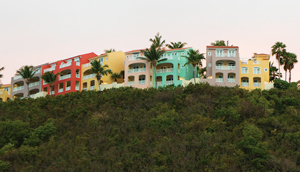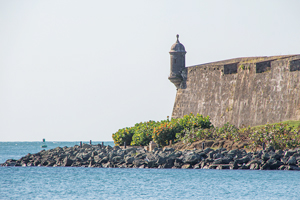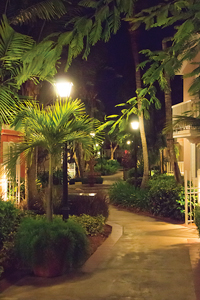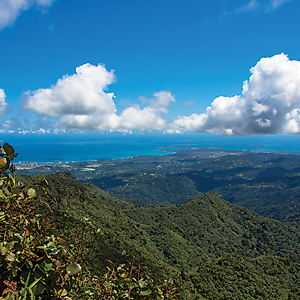I wanted to kiss the tarmac when we landed at San Juan Airport, even though it would have burned my lips. But that heat is exactly what we had come for. It was early March. For months, Richmond had been shaken between the glacial fangs of a snarling, slavering icehound named Polar Vortex. So when my wife, Dena, asked me for criteria for a spring break trip, I supplied one word: warm. She added a few more pragmatic inputs (affordability, ease of travel) to the Moore Travel-O-Matic and pretty quickly came up with Puerto Rico.
As the easternmost of the Greater Antilles islands, Puerto Rico is a convenient (and relatively affordable) three-hour flight from Washington. As a United States territory, it is a domestic destination for American travelers – which means no passport is required, its currency is the United States dollar, and most American cell phone plans work seamlessly. The official language is Spanish, but nearly everyone speaks English. (Although it is courteous to at least try to begin and end a conversation with buenos dias and gracias.)
In many ways, Puerto Rico is less foreign than, for example, Texas. And yet, to arrive in Puerto Rico is to be plunged into a place indisputably, lusciously, intriguingly other. It feels at once Colonial and Caribbean, American and European, New World and Old World. The glass-and-steel high-rise hotels on Isla Verde look over the stone forts of San Cristobal and San Miguel, monolithic brutes with ten-foot thick walls that stood impregnable during the era of the cannonball. Cruise ships the size of Short Pump Town Center nose up against the walled city of Old San Juan. Street musicians playing reggaeton perform on the sidewalk in front of a Starbucks.
And then there’s the climate. High temperatures average in the mid to upper eighties year round, and with the surrounding ocean to pump up the humidity, it was like being transported directly from a Siberian winter to the middle of a Richmond July.
So with that as background, I now present at least one way to spend four days in Puerto Rico.
 DAY ONE: Arrival, transport to hotel, shopping, and exploring.
DAY ONE: Arrival, transport to hotel, shopping, and exploring.
Although we landed in San Juan, our ultimate destination was El Conquistador, a resort in Fajardo, a town on the northeast coast, about an hour’s drive from San Juan. We rented a car and launched into the adventure of Puerto Rican driving, which despite its sketchy reputation is no worse than driving in say, D.C. rush hour. But the slow pace of travel gave us the kind of special bonding time families only get when traveling to exotic destinations.
Me: I think they named El Conquistador in my honor.
Dena: You took the wrong exit.
Me: The sign said Fajardo was oeste.
Ben: You took the este exit, El Conquistador.
Sam: Anyone know the Spanish word for u-turn?
 One giro de 180 and thirty minutes later, we arrived at El Conquistador. As these sorts of places go, El Conquistador leaves very little off the list. The place is immense with five villages; each has its own accommodations, pools, and dining. If you’re a golfer, there are eighteen holes for you. (I’m not a golfer, so I can’t tell you more than that, except that the course looks tough.) When you need to feel pampered, there’s a spa, and after dark there is a casino for folks over eighteen and a kids club for the rest of us.
One giro de 180 and thirty minutes later, we arrived at El Conquistador. As these sorts of places go, El Conquistador leaves very little off the list. The place is immense with five villages; each has its own accommodations, pools, and dining. If you’re a golfer, there are eighteen holes for you. (I’m not a golfer, so I can’t tell you more than that, except that the course looks tough.) When you need to feel pampered, there’s a spa, and after dark there is a casino for folks over eighteen and a kids club for the rest of us.
Our village was called Las Casitas, the casitas being two- and three-bedroom condominiums with full kitchens. This can be a good option for families, with a little more space to stretch out, and the kitchen means you can cut back on resort dining, which is not cheap.
After we checked in, Ben and Sam departed to explore the resort while Dena and I headed into the town of Fajardo to stock the kitchen. There’s a Walmart, but there’s also a local market, which had better produce and was more adventurous. (You can, in fact, find non-English speakers in Puerto Rico.)
Afterwards, Dena and I did our own resort explore, which at El Conquistador can be more than a casual stroll. Most of the resort is on a bluff hundreds of feet above the ocean, and the terrain is not level. This geography also means there is no traditional waterfront. (Hence, if you want to step out of your door and onto the beach, El Conquistador is not your place.) You reach sea level via funicular, a narrow-gauge railway built along a precipitous descent. At the waterfront is a full-blown water park and a marina, where you catch the ferry for the 15-minute trip to Palomino Island, which is where Ben and Sam had gone while Dena and I grocery shopped. Palomino Island has the white coral beaches of your Caribbean dreams, along with a dizzying myriad of diversions, including kayaking, sailing, windsurfing, snorkeling, jet skis, beach volleyball, soccer, and that crowning achievement of refined resort living, cornhole. There’s even a stable housing rescue horses that can be booked for trail rides.
So there’s a lot to see at El Conquistador. The grounds are beautiful, bursting with tropical vegetation of all colors and descriptions, but it is also quite hilly. Dena and I were covering it on foot. At one point I fanned my shirt and said, “It’s too hot.”
Dena’s expression blew three months of polar vortex my way.
“I said you are hot, Darling! The weather is perfect!”
 Ben and Sam returned in the late afternoon, full of tales of adventure on Palomino Island, which included an account of an epic open-water swim to a second, smaller island several hundred yards off the shore.
Ben and Sam returned in the late afternoon, full of tales of adventure on Palomino Island, which included an account of an epic open-water swim to a second, smaller island several hundred yards off the shore.
Dena did not like the sounds of this unchaperoned side trip.
“It’s really shallow the entire way,” said Ben, “and there’s coral reefs and fish and everything.”
“I think I saw a shark,” said Sam.
“It was probably just a barracuda,” Ben reassured his mother.
As night fell, the lush vegetation came alive with the symphony of one of Puerto Rico’s wildlife treasures: the coquí frog. The coquí gets its name from the mating call of the male coquí, which is a high-pitched “coke-EE.” It was a happy, inquisitive sound, and it was everywhere at night. The song of the coquí became the soundtrack of our trip.
DAY TWO: Palomino Island
After breakfast at our casita and multiple applications of SPF to Infinity, we hit Palomino Island, taking advantage of nearly all of its activities. We swam and played most of the day, but always there was the matter of the smaller island, beckoning just off shore. It seemed to get closer on the incoming tide.
“You should try it, Dad!” said Ben, every time he caught me looking that way.
And finally I did.
I swam over silty sandy bottoms. I swam over jagged coral reefs. The bottom didn’t look so close. The island didn’t look so close. I swam. I swam some more. I began to look for Diana Nyad. I thought about Sam seeing a shark. I thought about that some more. Four days later, I felt sand between my toes and hauled myself ashore, gasping, heaving, kissing the sand, my relief undermined only by the fact that I had to do it all over again to get back. Gazing across the treacherous strait that separated me from Palomino Island, I saw the tiny figures of Ben and Sam standing happily on the opposite shore. They glowed with mirth. They waved and gave me the thumbs up. (Although from that distance, it could have been any finger.) But seeing them, my family, my children, gave me the strength I knew I would need to make it back.
So I could kill them.
 One more thing happened on Palomino Island that day. The kind of experience that makes an entire trip worthwhile. Finally tired of the beach, I took a hike along some of the trails that crisscross the island’s interior. I came to one of the island’s high spots, where I paused for a few minutes to watch a tropical rainstorm slowly sweeping in over the ocean. Just ahead of the curtain of rain, a weak waterspout began to whirl across the water’s surface. And then, a rainbow formed, brightened, and touched the water in the space between the clouds and the waterspout. Rainbow, clouds, rain, and waterspout, all playing across the tableau of the turquoise ocean.
One more thing happened on Palomino Island that day. The kind of experience that makes an entire trip worthwhile. Finally tired of the beach, I took a hike along some of the trails that crisscross the island’s interior. I came to one of the island’s high spots, where I paused for a few minutes to watch a tropical rainstorm slowly sweeping in over the ocean. Just ahead of the curtain of rain, a weak waterspout began to whirl across the water’s surface. And then, a rainbow formed, brightened, and touched the water in the space between the clouds and the waterspout. Rainbow, clouds, rain, and waterspout, all playing across the tableau of the turquoise ocean.
DAY THREE: El Yunque Rainforest
El Yunque National Forest is the only rain forest in the United States National Forest System, encompassing 28,000 acres on the slopes of Puerto Rico’s Sierra de Luquillo mountains. Rainfall of over two hundred inches a year creates an environment that is deeply lush and tropical. The park offers many activities, from eco-tours to swimming, camping, and hiking. Since we only had a half-day to visit, we struck out with a specific purpose: to hike to El Yunque peak. At 3,494 feet, El Yunque is the secondhighest peak in the Sierra de Luquillo.
The trail from the Palo Colorado Information Center was several miles each way and varied between gradients I would classify as very steep, extremely steep, and very extremely steep. But even my screaming quads were soothed by the dreamy landscape of mists and dripping waters and dappled half-light under the canopy far overhead. I wondered what it would be like to camp in such a place, with the chorus of the coquí added to the forest.
The last part of the trail was the steepest, including a cruel staircase carved across a sheer cliff face, but when we arrived at the peak, which is crowned by a stout lookout tower, the reward was a vista that encompassed nearly the entire eastern half of Puerto Rico. The slopes of the Sierra de Luquillo dipped away towards a broad, forested valley floor, and from there to the rocky coast, and beyond that, the horizon floating on a blue dream of ocean. And it was cool, even in the tropical sun. We had hiked above the heat. We could make out San Juan to the west, and with some careful eastward spotting we even located our resort, and Palomino Island, green against the aqua waters with its white coral beach a necklace of pearls in the sun.
A fitting reward for a strenuous morning’s work.
DAY FOUR: Old San Juan
We’d had our day at the resort, and we’d done the remote highlands, so on our last afternoon, we decided to take a trip to Old San Juan.
Old San Juan, as you might have guessed from the name, is the oldest section of Puerto Rico’s capital city, settled by Juan Ponce de León in the early fifteen hundreds. Old San Juan is actually a small island unto itself, and the oldest section is protected by an imposing stone wall that rises to forty feet in places. The equally impressive forts of Castillo San Felipe del Morro and the Castillo San Cristóbal anchor the two ends of the old city. Guided tours are offered, but we elected to explore them on our own, and the sheer scope and bulk of the fortifications is dazzling. These forts repelled all invaders for over four centuries, and it’s no wonder some have dubbed Old San Juan’s stone bulwarks the Gibraltar of the Caribbean.
 Today, Old San Juan is indisputably a tourist destination, as evidenced by the cruise ship docks and shops hawking trinkets. (One honest storekeeper even named his shop The Tourist Trap.) But it’s easy enough to get clear of the cheesier parts and discover the real joy of Old San Juan: walking its narrow, cobbled streets and enjoying its old-world plazas. Yes, it can be steep, and yes it can be hot, but there is always a café to find refreshment, or better yet, an old Spanish church.
Today, Old San Juan is indisputably a tourist destination, as evidenced by the cruise ship docks and shops hawking trinkets. (One honest storekeeper even named his shop The Tourist Trap.) But it’s easy enough to get clear of the cheesier parts and discover the real joy of Old San Juan: walking its narrow, cobbled streets and enjoying its old-world plazas. Yes, it can be steep, and yes it can be hot, but there is always a café to find refreshment, or better yet, an old Spanish church.
It was seeking a break from the heat that we found ourselves in the Cathedral of San Juan Bautista, the second oldest cathedral in the Americas. (The current building dates to 1540, though the cathedral itself was established in 1521.) The sanctuary was both majestic and contemplative, and as we wandered quietly through, we became counted among the sojourners who have found respite in that place for five hundred years.
Our day was capped off by dinner at one of Old San Juan’s many outdoor cafés. The heat of the day had abated and the sun’s illumination was slowly replaced by the honeyed light of street lamps and shop windows. Dinnertime conversation covered not only what we had managed to pack into four days, but also the things we wish we could have done, among them a nighttime trip to one of Puerto Rico’s bioluminescent bays, kayaking in a mangrove forest, and a trip to Monkey Island. We all agreed that a return trip was required.
After dinner we enjoyed a final stroll through the Plaza de Colón, which buzzed with activity. The city was just beginning to come alive and I understood why: Evening is the reward for surviving another day in the tropical heat.
The next day we would fly home, and two days after that it would snow again in Richmond. Polar Vortex was still stalking Virginia. So why not take one more lap around the plaza, duck down one more cobbled alleyway, inviting just a little bit of this mellow warmth to linger on our skin? And then carry home a simple answer to winter’s final winding howls: coke-EE.




